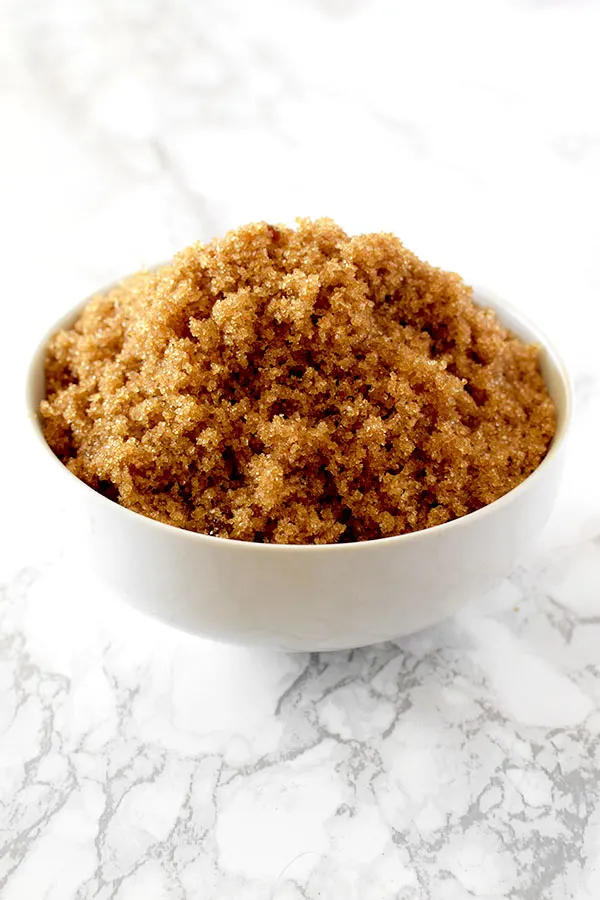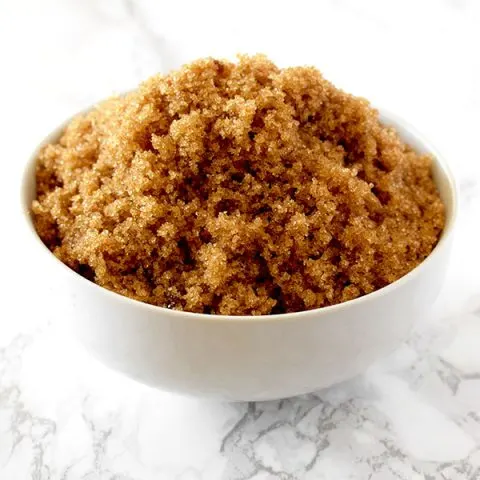Learn how to make light brown sugar easily with just two simple ingredients.
This is perfect for when you're in a pinch and don't have brown sugar on hand.

Brown sugar is what makes some of the best recipes - like chocolate chip cookies - so good.
Luckily, if you're out, it is really easy to make at home or substitute brown sugar.
All you need is regular sugar and molasses!
Sugar
The primary role of sugar is to be a sweetener. However, sugar also contributes to the tenderness and moistness of the baked good by absorbing and retaining moisture and helps create the golden brown color when baking as it caramelizes.
Recipes with more sugar often result in softer, moister textures. However, I learned the hard way that too much sugar leads to a sticky mess.
When it's heated, sugar caramelizes, resulting in a rich, complex flavor and a brown color. This adds both flavor and color to baked goods and is also the process in which caramel sauce, dulce de leche, caramel candies, and regular candies are made.
When used in recipes containing yeast, the sugar is eaten by the yeast, producing carbon dioxide and causing the dough to rise.
Sugar also acts as a preservative in jams, jellies, and fruit preserves by reducing water activity and preventing microbial growth.
There are many different types of sugar, including white sugar, brown sugar, vanilla sugar, powdered sugar, turbinado sugar, and demerara sugar.
When a recipe calls for “sugar” without specifying anything else, it's referring to regular white sugar.
White Sugar
White sugar (sometimes called granulated sugar, table sugar, or white granulated sugar) is made of either beet sugar or cane sugar, which has undergone a refining process.
It is the easiest to find and most commonly used.
Brown Sugar
Brown sugar is white sugar with molasses added to it.
It is commonly used in chocolate chip cookie recipes, and it’s rare for a recipe that calls for brown sugar not to also call for white sugar as well.
When a recipe calls for “brown sugar” but doesn’t specify what type (light or dark), it is referring to light brown sugar.
In my recipes, you can use whatever type of brown sugar you have on hand, whether it is dark brown sugar, light brown sugar, or demerara sugar - which is very common in Israel.
Just keep in mind that the flavor and color will be slightly different, depending on what you choose to use.
Turbinado Sugar
Turbinado sugar is better known as "raw sugar." But, despite this name, the sugar is not really “raw.”
Instead, it's partially refined sugar that retains some of the original molasses.
The term "raw sugar" may also give off the impression that it is somehow healthier.
In reality, turbinado sugar is nutritionally similar to white sugar.
Demerara Sugar
Demerara sugar is very popular in Israel and is especially delicious in tea, but is also used for baking.
Unlike white sugar, demerara sugar undergoes minimal processing and retains some vitamins and minerals.
However, it is still not much healthier than white sugar.
Vanilla Sugar
Vanilla sugar is not very common in the States. However, it is common in Israel and parts of Europe.
This is sugar that sat for an extended period of time with vanilla beans, giving it a vanilla flavor.
Caster Sugar
This type of sugar is common in the United Kingdom.
It has a grain finer than white (granulated) sugar and larger than powdered sugar.
Caster sugar is often called for in recipes for delicate baked goods like meringues, souffles, and sponge cakes.
You can use a 1:1 conversion rate between caster sugar and white (granulated) sugar.
Powdered sugar
Powdered sugar, sometimes known as confectioners’ sugar, is a sugar with a powdered texture.
This sugar is rarely used for baking. Instead, it is used for dusting desserts and making frosting, icing, and glazes.
In some countries, you can also find powdered vanilla sugar.
It is made the exact same way regular vanilla sugar is made. However, the sugar used is powdered instead of granulated.
Vanilla Extract vs Vanilla sugar
In my recipes, I don’t specify what kind of vanilla to use.
The reason for this is that in the States, vanilla extract is exclusively used.
Meanwhile in Israel, along with many European countries, vanilla sugar is common.
In most, if not all recipes, both vanilla extract and vanilla sugar can be used.
In recipes where vanilla sugar can be used instead of extract, you can replace them 1:1.
Replacing Sugar with Honey
If you’d prefer to use honey instead of sugar, you can do so with pretty good results.
Honey can be two or even three times as sweet depending on the honey, so for every 1 cup of sugar, you can use ½ to ⅔ cup honey.
Since honey adds liquid, you need to remove some to balance it out. For every cup of honey, remove a ¼ cup of liquid.
Also, it burns faster than granulated sugar, so you want to lower the baking temperature by 25 F. In addition, check it early and often to avoid burning or overbaking.
How to Store Sugar
Sugar should be stored in an airtight container to prevent clumping and moisture absorption, and kept in a cool, dry place.
BROWN SUGAR
What we call brown sugar is essentially white sugar that has had molasses added back to it.
It should not be confused with raw sugar or demerara, which are their own types of sugar.
You can easily substitute brown sugar or even make brown sugar.
Both dark and light brown sugar can easily be made at home if you have a little white sugar and molasses.
It is commonly used in chocolate chip cookie recipes, and it’s rare for a recipe that calls for brown sugar not to also call for white sugar as well.
When a recipe calls for “brown sugar” but doesn’t specify what type (light or dark), it is referring to light brown sugar.
DARK BROWN SUGAR
Dark brown sugar can be made with 1 cup white granulated sugar and 2 tablespoons molasses.
Add both ingredients into a bowl and mix with a fork until completely mixed.
LIGHT BROWN SUGAR
Light brown sugar can be made with 1 cup white granulated sugar and 1 tablespoon molasses.
Add both ingredients into a bowl and mix with a fork until completely mixed.
DEMERARA
Demerara is popular in Israel and is easier to find than light brown sugar. It is a type of cane sugar with a nice toffee flavor and can be used in place of brown sugar.
HOW TO SUBSTITUTE DARK AND LIGHT BROWN SUGAR
DARK BROWN SUGAR
Dark Brown Sugar can be made with 1 cup of light brown sugar and 1 tablespoon molasses.
Add both ingredients into a bowl and mix with a fork until completely mixed.
LIGHT BROWN SUGAR
Light Brown sugar can easily be replaced in a recipe with half dark brown sugar and half white granulated sugar.
DOES THE TYPE OF BROWN SUGAR YOU USE REALLY MATTER?
Using the wrong brown sugar will change the flavor and likely the color.
Dark brown sugar has more molasses, which will give it a deeper, more complex flavor that’s closer to toffee or caramel.
Light brown sugar is more subtle, which is sometimes ideal.
However, I tend to use what's on hand, which for me means dark brown sugar in Israel and light brown in the States.
I also happen to love the extra flavor dark brown sugar gives, so I like using it even if I have both on hand.
How to Store Brown Sugar
Store brown sugar in an airtight container to maintain its moisture and prevent it from hardening.
Types of Molasses
Molasses is a byproduct of making sugar from sugarcane or sugar beets.
The process goes through three boiling cycles, and with each cycle, a different type of molasses is created.
There are five types of molasses: blackstrap, light, dark or medium, treacle, and sorghum (which is technically not a molasses).
The lighter the molasses, the sweeter it is.
Light Molasses
Light molasses is the syrup that remains after the first processing of the sugar.
It is the lightest in color as well as sweetest in taste.
This type of molasses is often used as a syrup for pancakes and waffles or is stirred into hot cereals such as oatmeal.
Medium or Dark Molasses
Medium or dark molasses is made from the second boiling of the sugar.
It has a naturally darker color and thicker consistency.
It has a little stronger flavor than light molasses, but not as strong as blackstrap.
It is the type commonly used in gingerbread.
Blackstrap Molasses
Blackstrap molasses is the syrup remaining after the third extraction of sugar from sugarcane.
The word "blackstrap" comes from two seperate words.
"Black" refers to the color of the molasses (which is extremely dark), while "strap" is derived in part from the Dutch word stroop, meaning "syrup".
It has a very strong, somewhat bittersweet flavor with a heady aroma.
It is best used in recipes rather than as a straight sweetener such as pancake syrup.
It contains many of the nutrients left behind by refined sugar crystals, so some people feel it is healthier.
Treacle
True treacle dates back to Victorian times. However, today, treacle is a blend of molasses and refinery syrup.
It is notably sweeter and has a much more mellow flavor than molasses and ranges in color from light gold to nearly black.
British treacle can be substituted for molasses in most recipes, but much less frequently will molasses work as a replacement for treacle.
Sorghum Molasses
Technically, sorghum, also referred to as West Indies or Barbados molasses, is not molasses.
It comes from the sorghum plant, a cereal grain, which although grown specifically for molasses, is not refined sugar.
The syrup is made from the juice of the stalk which is cooked and clarified, resulting in a smooth, clear, amber color.
Sorghum molasses generally contains a preservative which is added to lengthen its short shelf life.
Since it can ferment, sorghum molasses should be refrigerated.
How to Store Molasses
Store molasses at room temperature in a cool, dark place.
Can You make brown sugar with blackstrap molasses?
Yes!
You can generally use any molasses for making brown sugar, but blackstrap is sometimes easier to find.
When you use blackstrap molasses to make brown sugar, it may smell a little strong, but the color will be right and the flavor will be perfect in baking.
In fact, it is my preferred type of molasses when making brown sugar.
How to Make Light Brown Sugar

Making light brown sugar at home is super easy and all you need is regular sugar and molasses.
Ingredients
- 1 cup white or caster sugar
- 1 tablespoon molasses
Instructions
- Place sugar in a bowl
- Add molasses
- Mix until color is uniform
Nutrition Information:
Yield:
48Serving Size:
1Amount Per Serving: Calories: 17Total Fat: 0gSaturated Fat: 0gTrans Fat: 0gUnsaturated Fat: 0gCholesterol: 0mgSodium: 0mgCarbohydrates: 5gFiber: 0gSugar: 4gProtein: 0g